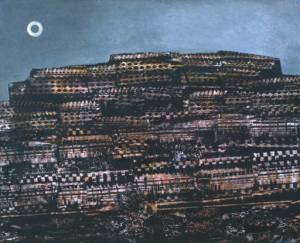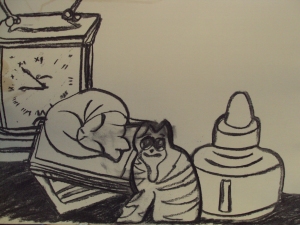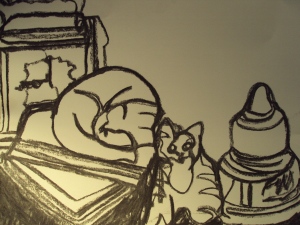To commence this assignment, I utilised the skills developed in previous experiments with line, form and composition to create what I hoped would be an arrangement of man-made objects that was both visually stimulating and reflected personal interests and emotional aspects of myself:

Running shoe, swimming goggles, shoe laces, iPod Shuffle, knee support, pencil case (background) assembled on wood table
This quick initial pencil sketch enabled me to assess aspects of the composition that were strong, but also identify those that were weak. For example, I was worried that the swimming goggles, although reflective of the intricate lines of the shoe laces, overcomplicated the arrangement and detracted from the contrast between the shoe itself and the area of almost negative space provided by the knee support, which had little texture aside from weaving in the fabric. Nevertheless, I was unsure whether to remove the goggles, as I felt that the curved lines and general form complimented the swirling laces in the same manner as running compliments swimming: the two marry together to prevent injuries (and their accompanying heartache), as represented by the knee support.
However, for the purposes of development, I decided to remove the goggles to see whether it would strengthen the individual identity of the shoe, which, like my love of running, was intended to be the main focus of my study. Although compositionally interesting, including the background detracted from the way the objects related to one another at this early stage: re-introducing it at a later point would allow me to compare proportions, heights, depths and forms. Hopefully, this would result in more informed development of the composition, and also the tonal relationships within the composition.

Compositional development and media experimentation (black and white): brush pen (line only), charcoal pastel, fineliner (hatching), charcoal, biro (cross-hatching)
Completed within the first study session (of three), this page details my experimentation with media in black and white, composition and viewpoint. I felt that my earlier successes with elevated viewpoints created a better sense of solidity within the objects: my initial sketch lacked this solidity and depth, resulting in the objects seeming rather flat. In the first line drawing, I was able to identify formal relationships within the objects and the way that the shoe laces often seemed to absorb the objects in front of them due to their intricate forms, almost entangling the ipod and separate laces in their curved, weaving web. The resultant loss of identity of the objects in front of the shoe led me to reconsider the composition: although shapes within the still-life were more relevant than the objects in themselves, I still wanted the final composition to feature aspects of every intriguing form. Losing too much of those forms would create a sense of confusion and chaos that was not my intention for the piece. Man-made forms, in many respects, seem rather structured and graphic/illustrative in quality, and this is something I wanted to reflect in my final piece.
Further development of the object arrangement and viewpoint (front-on) in charcoal pastel emphasised a problem in the compositional process: strong shapes and forms, particularly in the arrangement of the laces, abound in both a side and front-on view of the shoe. This led me to wonder whether the addition of a second shoe could alleviate this issue, or whether it would make the arrangement too busy and muddled. Charcoal pastel was also not the ideal medium for such a detailed piece, as many details became blurred and much of the texture/patterning of the shoelaces lost. However, it was helpful for sketching the perspective of the shoe quickly and identifying the strong structures within the shapes through overlaying/drawing as if the objects were transparent as in an earlier exercise with square/rounded objects, due to the bold, unwavering quality of the lines created by the medium.
Altering the composition again to draw the shoe from behind in fineliner added an intriguing dimension to the formal relationship between the looping laces and ellipses forming the texture of the front of the trainer, accentuating the connection between the two due to the foreshortening of perspective created by the viewpoint. I found this viewpoint highly challenging to draw and the result is not accurate, the angle of the trainer skewed by my inability to render the angle of the shoe in addition to the difference in depth/graduation from heel to toe. The graphic quality of fineliner leant itself to the shapes and structure of the objects well, but having explored this medium for most other earlier pieces I wanted to challenge myself more for the final composition. Hatching and cross-hatching proved ineffective and detracted from the detail of the shoe, and also made it difficult to define the texture of the laces and other elements clearly. Consequently, I suspected that the softer approach to shading provided by pencil and/or charcoal might be more appropriate for the final composition.
Charcoal and biro in the final two drawings emphasised the contrast between soft and harsh lines present in both the potential choice of media and the compositional arrangement: smudging the charcoal blurred the lines excessively and resulted in a loss of detail and accuracy, yet the harsh lines created by biro and hatching did not capture the soft curves of the laces, iPod edge and knee support with particular flair. I was still not satisfied with the composition or viewpoint at this stage, so for the next series of drawings I chose to reduce the components and viewpoint to a more simplistic arrangement to allow me to discern potential compositional strengths and weaknesses further.

Colour sketches showing possible variations and materials used: consistent composition: chalk pastel, oil pastel, conté crayon, colour pencil, biro, permanent marker (stylised).
To concentrate on possible variations in materials, and the process of introducing colour, I kept the working composition consistent. I removed the knee support altogether as I felt that the sense of negative space created by its lack of texture and blank form stood out too much in the composition and did not allow the eye to roam around the arrangement or appreciate the flowing lines of the shoe laces and other elements.
Instead, I included a sticker sheet with round-edge squares and hearts, shapes that complimented the combination of straight lines and curves present in the form of the iPod.
I attempted to stylise each image slightly depending on the medium, but on reflection decided that for my first project an attempt at accuracy would be best: before attempting anything abstract or overly expressionist it is first necessary to develop an understanding of tone, line, shape and form. Distorting these elements without studying them first would lead to misinformed decisions and possibly weak pieces.
Nevertheless, the bold graphic result provided by a minimal palette using biro and permanent marker in drawings five and six again illustrated the graphic potential of the arrangement of objects, while softer media in the first three drawings (chalk pastel, oil pastel and conté crayon) allowed me to explore shading and blending tones within the arrangement of objects. Colour pencil in drawing four produced perhaps the strongest result, with a good balance between definition and tonal variation. This led me to suspect that either pencil or colour pencil would be most appropriate for the final piece.
This colour sketch finalised my decision to render my final piece in black and white. Although the tonal relationships were enlightening to explore, I felt that form and line were the most crucial elements of this composition, and using colour rather lost those relationships. When I first set out to create the final piece, exploring form and line was my primary intention and the particular arrangement of the group of objects, along with the illustrative quality of the clean lines and pattern of the running shoes being the primary feature of the still-life arrangement. This sketch allowed me to explore tonal relationships, meaning that I understood those relationships in depth before detailing them in the final piece, but the soft medium of conté crayon, along with the variation in colour and tone, detracted from the focus on the shapes and relationships between the objects, particularly in terms of positive and negative space. However, the tonal gradient on the background wall was something that I found positive about this sketch, as it captured the sense of light and shadow accurately (this is something I often struggle with), so I endeavoured to retain this accuracy in my final piece. Adding the swimming goggles and an extra running shoe to the composition, along with elevating the viewpoint further, added depth to the arrangement. Deliberately leaving some of the objects half-fitting onto the page also created a sense of space outside of the composition, a sense that there was a world around the image and an accompanying visual intrigue, as opposed to the objects being isolated in a singular world that did not extend beyond the edges of the paper. This helped them to seem more ‘real’, more tangible to me. In addition, draping the goggles over the shoe and brightening the light source coming from the top right allowed the shadow of the goggles to differentiate them from the shoes, avoiding the tonal blurring that earlier led me to remove them from the composition.
In this final piece, I attempted to combine all of the positive elements of my previous studies both for this assignment and in my previous exercises. A slightly elevated viewpoint, along with a stronger light source from the right lended three-dimensionality to the objects. The proportions and sizing of the components are reasonably accurate, though once again there is room for improvement in this regard, particularly in relation to the perspective of the left-hand shoe. Adding another shoe to the composition highlighted the interesting shapes that I felt were overlooked from a side-on or front-on only view of a single shoe, something the preparatory work allowed me to see. I feel that I sufficiently explored the range of options available in terms of media and composition in my preparatory sketches, but I could have experimented more with mixing media to render texture, something that I feel was rather neglected until the final two drawings. I don’t believe this piece is as strong or innovative as my mixed media paint jar/feather assemblage from an earlier exercise due to the mundane manner in which I simply combined soft and hard pencil to render texture. For the natural objects still life, I will certainly explore mixed media possibilities further. Nevertheless, the simplicity of pencil has allowed me to concentrate on the form and line of the objects, in what would otherwise have been an excessively complicated arrangement had colour been added to the final image. In this respect, it may indicate that the composition was, in the end, overcomplicated and some elements should have been omitted.
I would not alter the arrangement of the objects if I were to repeat the exercise, as my compositional experimentation formed the most extensive part of my preparatory work and I believe my decisions were informed in this respect. Working on a larger sheet of paper (the drawing is A2) would not have strengthened the drawing because I deliberately chose to structure the image so that parts of the objects did not fit onto the page, lending a sense of continuation beyond the boundaries of the paper’s edge/frame ~ hopefully, this was a successful decision from an external viewer’s perspective.
The earlier exercises prepared me well for drawing such complex objects, arrangements and shapes. Techniques such as hatching and cross-hatching were not overly problematic, again due to earlier practice. Overall, there is room for improvement in the image, but I feel I have learnt from my first assignment and can carry this knowledge over to develop the second element, a still-life composition of natural objects.

































